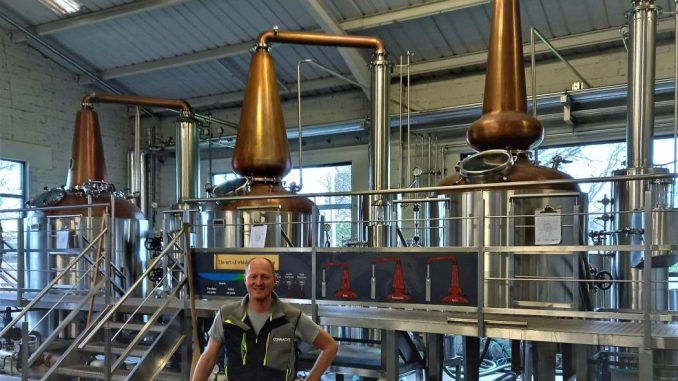
(Note from the author: This is a automated translation of the original German article)
One of the distilleries I’ve been most excited about in recent
years is located in the west of the Emerald Isle. In the town of
Ballina, a small team of US-Americans founded The Connacht
Distillery in 2013. Their goal: to produce the first legal whiskey
in the Mayo region in 150 years. Over the years, they learned that
the path to this goal did not require a straight runway, but rather
a joint effort. Finally, in the summer of 2021, the first single malt
Irish whiskey was released. In the meantime, Ryan Friesen, a new
head distiller, joined the team. With Myles „Milo“ Molloy, the
young distillery also gained a new finance director, who takes care
of the many operational issues on site.
About the last one, the contact arose in the summer of 2022, which
led me in late autumn of the year from County Kerry to the west
coast of the Irish island. On the agenda was a tour of the
Connacht Distillery with Head Distiller Ryan Friesen. He greeted
me directly when I entered the reception room in Ballina at the
agreed time. „We’ve been expecting you,“ he said graciously at the
opening. Ryan Friesen is a young, slim man with short, reddish
hair. He appears dynamic, his eyes lively. After some small talk,
Milo joined us from the back. He shook my hand and was happy that
after several months it now worked out with my visit.
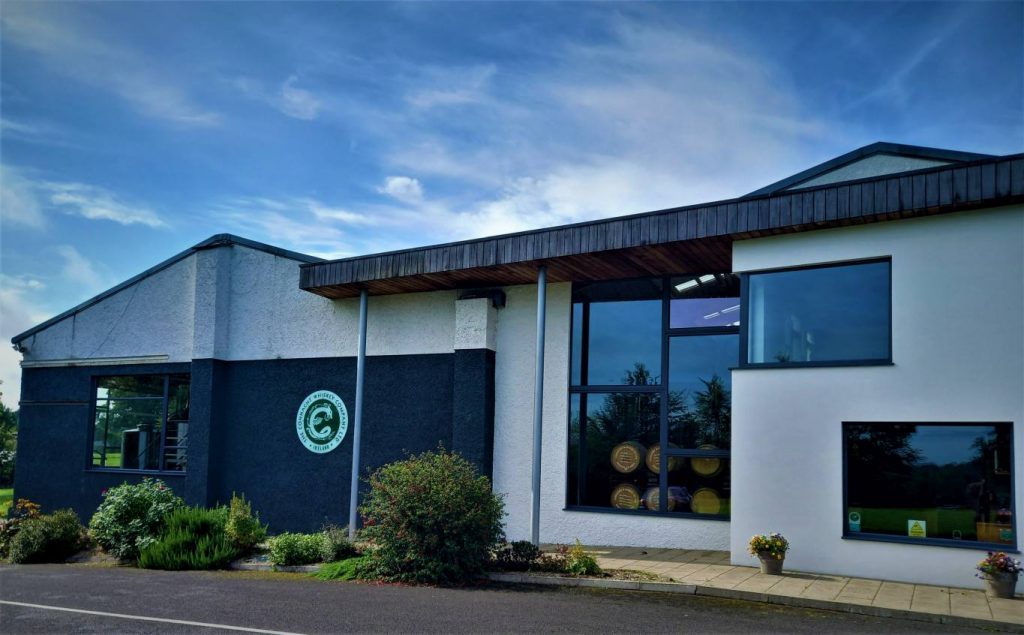
The Connacht Distillery and Head Distillery Ryan Friesen
The three of us go into a small bar room next to the reception
room. Autumn light streams into the room through the large window
front. To the right, we look through more windows into the
distillery. The brewing equipment obscures the view of the still
at the far end of the hall. In contrast, to the left is a counter
and the distillery’s products are lined up behind it. The logo of
the distillery hangs as an artistic mirror, centrally on the back
wall.
We go to a corner table by the window. It is shortly after one
o’clock noon. Milo offers me a lunch of sandwiches, but I had
already eaten on the way there and decline. Ryan sits down on a
bar stool at the counter, Milo takes a seat with me at the corner
table. The two eat a little and we talk about my recent visits to
other distilleries.
A tour of the Connacht Distillery with Head Distiller Ryan Friesen
After they have eaten up, Milo leaves us and I go with Ryan to the
distillery. While he was still reserved during the meal, he now
literally blossoms. Ryan Friesen, Head Distiller at Connacht
Distillery starts his tour with me at the brew kit. „Our brew kit
holds 3,000 liters. It was built in Germany,“ he explains to me.
„As many processes as possible run automatically,“ Ryan continues.
In a separate room behind the brewing equipment is a roller mill.
This exclusively processes ale malt and uses it to feed the Lauter
Tun in the main room via a pipe connection. „We use 575 kilograms
of malt per batch. That makes 30,000 kilograms a year,“ Ryan
calculates.
The distillery transfers surplus grain residues after mashing to
farmers. The farmers use these as cattle feed and organic
fertilizer. The finished mash itself is then blended with a
standard yeast. „Our fermentation time averages three days.
After that, the resulting wash has an alcohol content of about
eight percent.“

Double malt whiskey
Time for distillation. Ryan Friesen and I walk through the
production hall and step in front of the three copper stills. I
ask about their size. To this the Head Distiller of the Connacht
Distillery says: „We have 3,000 litres, 1,700 litres and 1,400
litres capacity. The plant is heated with steam. It’s made in
Canada and custom-built to Master Distiller Robert Cassell’s
specifications.“ Ryan leads the way up the metal stairs. We are
standing in front of the wash still, which is currently running
at full speed.
Looking at the circular viewing window, he catches sight of
something. A moment later, he turns three levers next to the
apparatus. „See those dark particles in the window?“ he asks me. I
look and see what he means. Foam is clearly rising behind the
window, leaving tiny black particles on the glass. „I was
adjusting the temperature. The system was running too hot,“ the
professional explains. A young employee appears behind us. Ryan
informs him that the operating temperature has been lowered.
We go down again and stop in front of the plant. Now Ryan goes
through the distillation process: „There are three pot stills, but
we distill our malt whiskeys twice,“ he begins.
„After the first distillation, we have low wines with an alcohol
content of 23 to 25 percent. We collect two runs of these and then
put them into the Spirit Still. Again, from this we take the
Hearts as our Malt New Make and for our Poitín.“ The single malt
distillate now has 69% alcohol by volume.
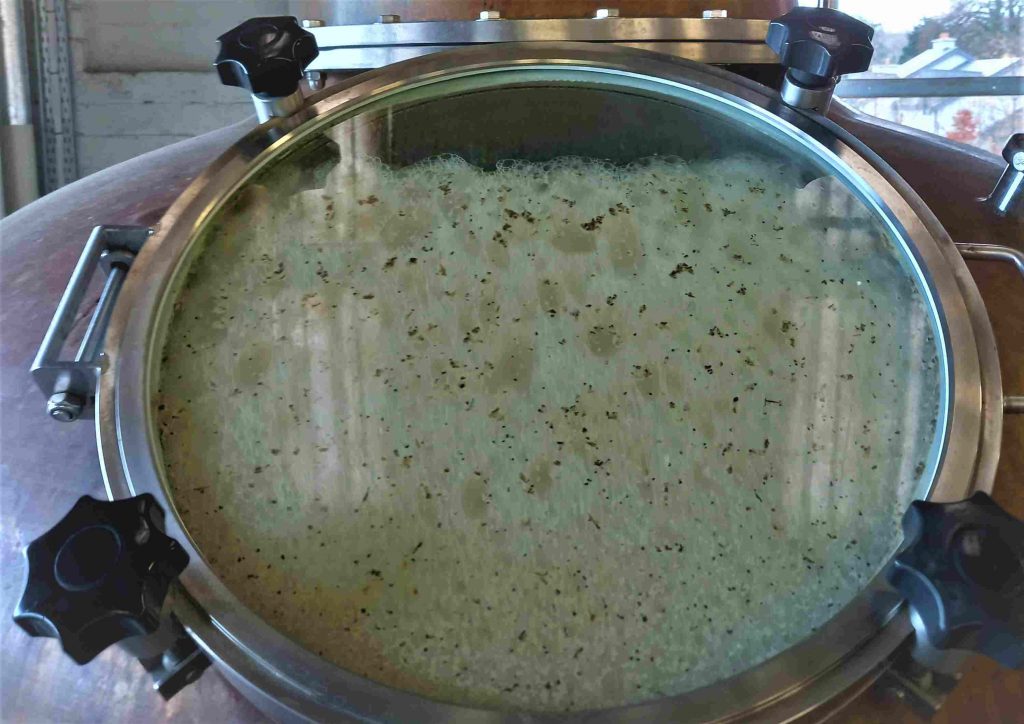
Heads, hearts, tails and bourbon barrels
Interesting is the use of the third still of the Connacht
Distillery. Head Distiller Ryan Friesen: „We make very wide cuts
with the heads and the tails. This means that they contain a lot
of good substances. We collect both and distill it one more time
on the third still.“ Besides, the third still is used for gin
distillation and for the production of vodka.
The distillery fills the finished distillates into barrels on
site. Until now, each whiskey first came in ex-bourbon barrels.
The distillery currently stores a total of 2,000 barrels, a large
part of them in its own warehouse. Another part rests in an
external warehouse nearby. Now we go to the back part of the
building complex. There are two warehouses here. One of them is
exclusively barrel storage. The other both warehouse and work
shed. Cartons and pallets of bottles are stacked here, and the
company’s own bottling line is located inside.
„We don’t leave the whiskeys exclusively in bourbon barrels, of
course,“ Ryan points to a group of sherry butts.
„Here, for example, we use ten sherry casks for finishes,“ he
explains. Thus, the first whiskey release of the distillery also
received a sherry stamp, the four-year-old single malt whiskey
finally stored in 500 liter sherry casks. At first, a Collector’s
Edition appeared in a high-quality presentation box. This
contained the single malt whiskey from the very first barrel that
the distillery had filled in 2016.
Shortly after, the first standard bottling was released with
Single Malt Batch 1. „This one will remain unique in form,“ Ryan
reports. „The malt whiskey will remain, but it will not have a
batch designation in the future.“

Focus on Single Malt Whiskey
Overall, the product line will keep the focus on single malt Irish
whiskey in the future. Ryan Friesen, who has been Head Distiller
at Connacht Distillery since the beginning of 2022, spent the
first few months modelling the current production according to his
ideas. In the process, he’s only casually considered new products
or even other styles of whiskey. „It’s a bit of an embarrassing
story, but at the beginning of my time, people asked me if we were
doing pot still whiskey. I answered in the affirmative because I
thought that meant plain whiskey distilled on pot stills.“ He
laughs out loud. In fact, he has since acquired considerably more
knowledge. Even about pot still whiskey „I think pot still whiskey
is very interesting. The whole category represents diversity and
is a unique selling point for Irish whiskey. We’ll take a closer
look at it when the time comes,“ he says.
An US craft distiller in County Mayo
Ryan Friesen comes from the US Craft Distilling. Originally from
the state of Indiana in the northeast of the United States, he
learned distilling at the Journeyman Distillery in neighboring
Michigan. From there, he was drawn to California. On the sunny
west coast he started his own Craft Distillery
Blinking Owl. At the same time, he took over the vice chairmanship
of the California Artisanal Distillers Guild, an association of
local craft distilleries.
Ryan built up his wealth of experience with the various
distillates of the Blinking Owl Distillery. These included bourbon
and rye whiskey. Wheat was also used in the mashbills time and
again. So he knows a lot about different kinds of grains. A
circumstance that can still benefit the Connacht Distillery and
its Head Distiller, should they produce Irish Pot Still Whiskey at
some point. „I like to prepare everything neatly and then mainly
let the raw materials themselves do their work. Basically, every
whiskey behaves the same during distillation. You end up with a
spirit that’s ready to be bottled, but it tastes very different
depending on the grain,“ he explains.
Vodka. And a US craft distiller in Japan
Besides experimenting with grains and recipes, distilling vodka
was Ryan’s greatest joy. Here he was fascinated by the demanding
production method: „Distillation, at least on the stills at
Blinking Owl, was always on a knife’s edge. A little too
much or too little steam and everything could fall off the edge.“
Ryan was able to learn very special insights in Japan. That’s
where Blinking Owl sent him for an internship at the beginning of
his term, at Chichibu Distillery to be precise. „It was only eight
days, but they were lifechanging experience,“ he looks back. „I
got to follow the team through the entire production process. From
the cooperage to the distilling process to selecting barrels in
the warehouse. The samples from that were used by owner Ichiru
Akuto in a tasting with me.“
The foundation of Connacht Distillery
While we are standing between the barrel shelves in the Warehouse,
Milo comes back to us. Ryan shows him a wet spot on the floor. Tap
water was from pipes on the ceiling
leaked. „We fixed that,“ he reports to Milo. „We just have to
clean up the mess.“ Milo nods with satisfaction. We walk back
through the work floor, through production, and back to the bar
room. Again we sit down at the table and Milo makes me a coffee.
Ryan leaves us to take care of a few things. I ask Milo a few
questions about the founding of the distillery.
Behind this is the Master Distiller Robert Cassel. He had already
founded a Craft Distillery in Pensylvannia in 2004 and had worked
as a brewer before. He brought this practical experience into the
founding team, which also consisted of the cousins P. J. Stapleton
and David Stapleton as well as Tom Jensen and John Romanelli. This
brought together decades of industry and professional experience
at the founding. Jensen, for example, was a board member and
managing director of Remy Cointreau USA, while financial expert
Romanelli was an executive at investment banks such as Bearn
Stearns and Credite Suisse in North America. While David Stapleton
looked back on a career in engineering companies in Ireland and
the UK and eventually in the recycling industry, his cousin P. J. was
a Chairman of the Pensylvania Liquor Control Board.
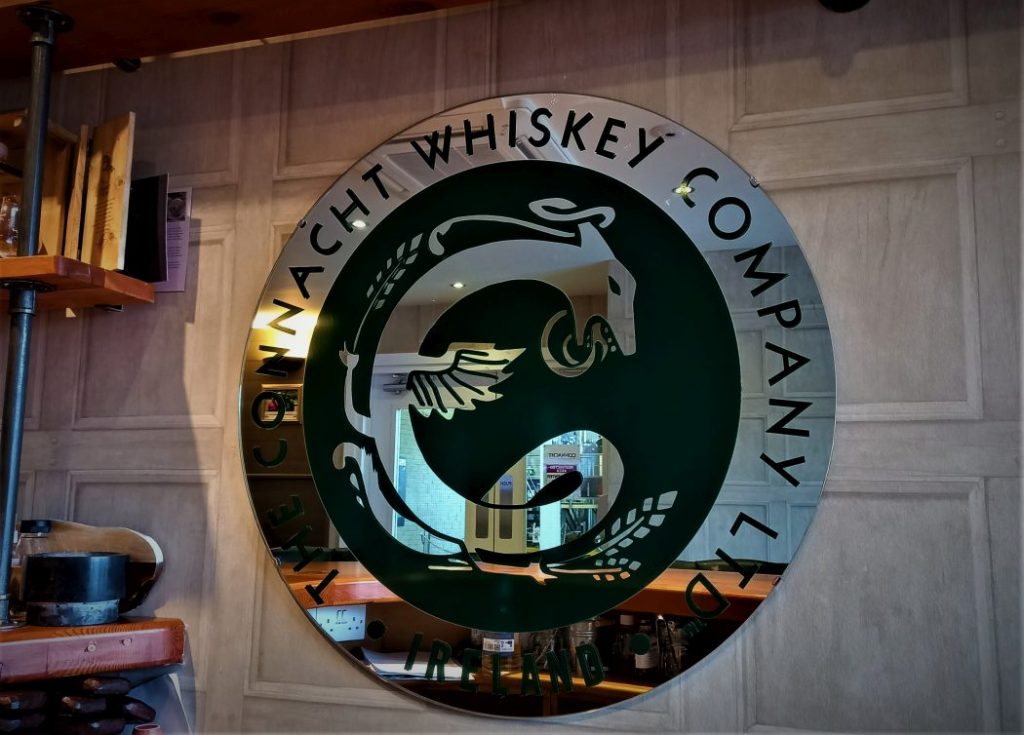
The first years
A thoroughly illustrious team, which also raised the necessary
capital for the foundation and construction of the distillery. In
2015, they transformed an old bakery in Ballina into a modern
distillery. In the following year, production started under the
leadership of Robert Cassel. The first products were Concullin
Irish Gin as well as Straw Boys Poitín and Straw Boys Irish Vodka.
A second gin, Kookie Irish Gin, was released in collaboration with
well-known local radio presenter Alan Clarke. Whiskey also entered
the market. For this, the distillery sourced finished distillate
from third parties. These bottlings under the brands Ballyhoo and
Spade & Bushel were well received by connoisseurs. Also in
Germany, where the distillery is represented from the beginning.
As all of the founders continued to pursue other ventures, it was
necessary to optimize production over time in order to set it up in
the best possible way. Myles joined the team in Ballina in 2021 and
Ryan in early 2022. In the meantime, co-founder David Stapleton
left the company.
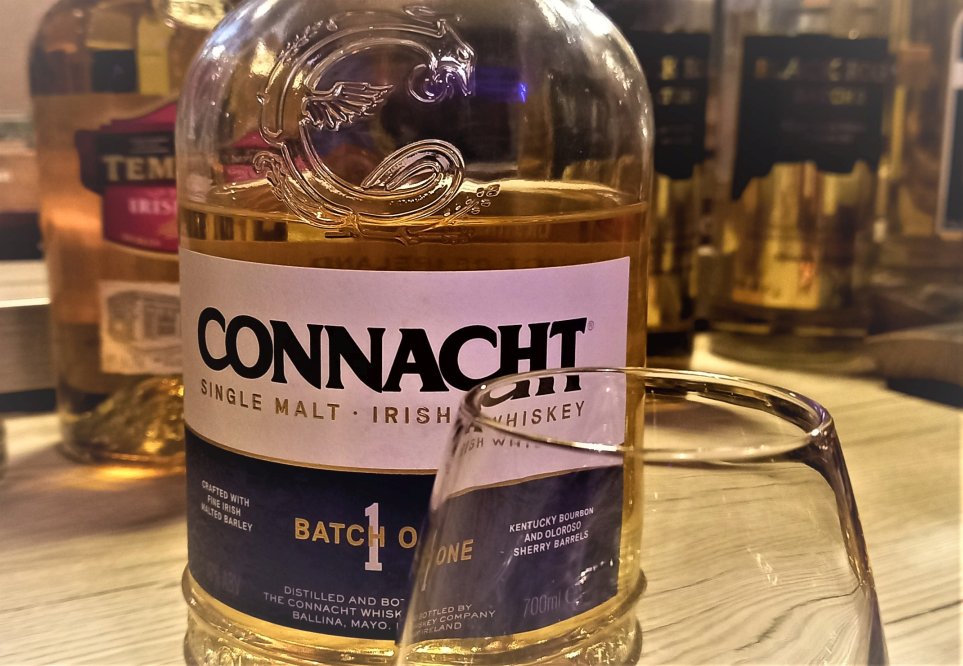
Firm and steady
So Myles Molloy and Head Distiller Ryan Friesen took the
reins in the day-to-day operations of Connacht Distillery.
They carried out the planned optimization of the operational
process. With this setup, Ballina is now set to move steadily
forward. The potential of the Connacht Distillery seems great
and the current players are the right
people in the right place. The successful release of the first two
whiskeys in summer 2021 underlines this positive development.
Thus, it is still curious about what will be created in the west
of Ireland in the future.
